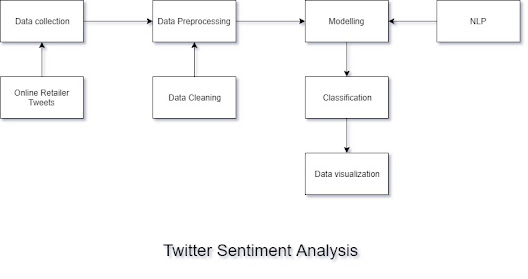Twitter Sentiment Analysis(TSA) - Online Retailers(2019-2021)
Project Overview:
Twitter Sentiment Analysis helps to understand the user experience of the online
retailers based on the tweets, which is important for business development and
product enhancement.This a online retailer problem so based on the tweets we are
giving the rating of each customer about online shopping experience.
Sentiment analysis architecture:
Scraping the tweets:
- Taking the tweets with respect to online retailers such as ebay, meesho, olx india, flipkart, amazon, jio mart.
- After the extraction of the data from twitter, put into the data frame with respect to retailers.
- Concatenating the data frame of each retailer into a single data frame.
- Converting the data frame to CSV file.
Data preparation and data cleaning:
- Importing the CSV file using pandas.
- Analyse & understand the nature of the data.
- Tweets are not actual text format, it contains no text characters, writing a function to clean that and passing into the tweets data frame.
Modelling:
- Once the data is cleaned, we will use the hugging face nlp model to predict the sentiment of tweets and give the rating based on the expression.
- Writing a function to apply the nlp model.
- Creating a new column and apply nlp function to data frame and finding the rating
- Removing the null value in the tweet column
Data visualisation:
- After finding the sentiment, count the rating of sentiment.
- Visualisualize the sentiment using Matplotlib.
Conclusion:
From the fig, we conclude that most people usually prefer to buy online. This is due
to Covid-19 and increasing mobile application & best user interface of some online
retailer web and mobile applications. Enhancing the customer support of the online
retailers helps in better production and sales.


Comments
Post a Comment